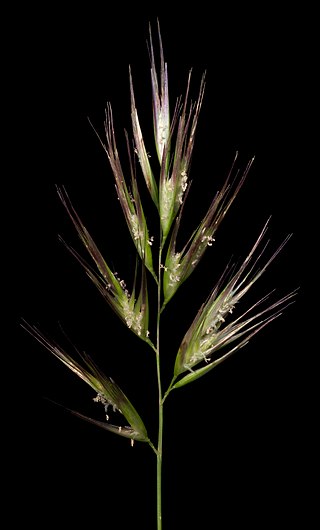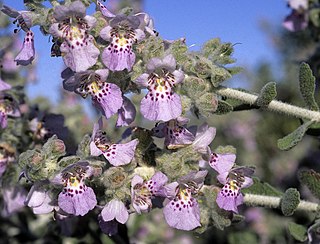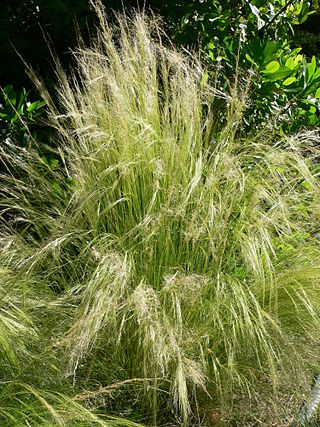
The Houtman Abrolhos is a chain of 122 islands and associated coral reefs, in the Indian Ocean off the west coast of Australia, about 80 kilometres (50 mi) west of Geraldton, Western Australia. It is the southernmost true coral reef in the Indian Ocean, and one of the highest latitude reef systems in the world.

Charles Gaudichaud-Beaupré was a French botanist.

Austrostipa is a primarily Australian genus of plants in the grass family, commonly called speargrass.

North Island is the northernmost island in the Houtman Abrolhos, a coral reef archipelago in the Indian Ocean off the coast of Mid West Western Australia. Located about 14 km (9 mi) from the nearest island group, it is one of the largest islands in the Houtman Abrolhos, and one of the few to support dune systems. It has relatively diverse flora dominated by chenopod shrubs and fauna that includes the introduced tammar wallaby, around seven species of reptile, and about 15 resident bird species.

The Abrolhos painted buttonquail is a subspecies of the painted buttonquail endemic to the Houtman Abrolhos. It is common on North Island, and also occurs on other islands of the Wallabi Group, namely East Wallabi, West Wallabi, Seagull and Pigeon Islands.
This is a list of the terrestrial flora of the Houtman Abrolhos. Only vascular plants are listed — there have been some collections of mosses, liverworts and lichens from the Houtman Abrolhos, but no information has been published on these non-vascular groups.

Pigeon Island is a small island located need the middle of the Wallabi Group of the Houtman Abrolhos, an archipelago off the coast of Western Australia. It is almost entirely given over to western rock lobster fishers' camps, and as a result is far more disturbed than most other islands in the archipelago. A nearby island also seasonally populated by fishers is named Little Pigeon Island, hence Pigeon Island is sometimes referred to as "Big Pigeon Island".
The Seagrasses of Western Australia are submerged flowering plants found along the coast, around islands, and in Estuaries of Western Australia. The region contains some of the largest seagrass meadows in the world, and is the most diverse in the number of species. The variety of habitats along its western and southern coasts is often soft sands in shallow subtropical waters, ideal for these plants.

Rytidosperma caespitosum, known by various common names including common wallaby-grass, ringed wallaby-grass, and white-top, is a species of grass native to southern parts of Australia.
Austrostipa variabilis is a species of grass in the family Poaceae that grows in southern parts of Australia.

East Wallabi Island is an island in the Wallabi Group of the Houtman Abrolhos, located in the Indian Ocean off the west coast of mainland Australia.

Quoya is a genus of flowering plants in family Lamiaceae and is endemic to Western Australia. Plants in this genus are shrubs with five petals joined to form a tube-shaped flower with four stamens of unequal lengths.

Nassella tenuissima is a species of grass known by the common names Mexican feathergrass, finestem needlegrass, fineleaved nassella, and Argentine needle-grass. It is native to the south-western United States, northern Mexico and Argentina. It is well-matched to climate in Australia and can be harmful to the Australian environment.

Caulerpa webbiana, commonly known as bottlebrush green seaweed, is a species of seaweed in the family Caulerpaceae.

Austrostipa elegantissima, commonly known as tall feather-grass, is a species of grass in the family Poaceae. It is native to southern Australia, from Western Australia to New South Wales. It grows as a decumbent perennial in a rhizomatous tussock with widespread leaves, and lacks basal leaves. It is found in areas that are not grazed by introduced livestock, which feed on this plant.

Ptilotus divaricatus is a shrub in the Amaranthaceae family.

Austrostipa hemipogon is a tufted, perennial grass (a member of the family Poaceae. It is native to Australia, and found in Western Australia, South Australia, Victoria, and Tasmania.

Adriana tomentosa is a species of plant in the Euphorbiaceae family and is endemic to mainland Australia.

Austrostipa mollis, also known as the soft speargrass or supple speargrass is a robust, erect tufted perennial speargrass in the Poaceae family. It is native to Australia, and found in Western Australia, South Australia, Victoria, ACT and Tasmania.

Schoenia cassiniana is a species of plant in the tribe Gnaphalieae within the family Asteraceae, native to Western Australia, South Australia and the Northern Territory. It was first described in 1829 by Charles Gaudichaud-Beaupré as Helichrysum cassinianum, but was transferred to the genus Schoenia in 1845 by Joachim Steetz.
















